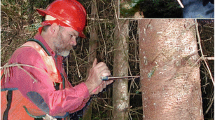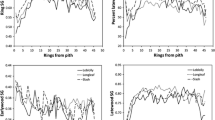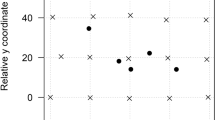Abstract
Key Message
The original method proposed provides useful data for the analysis of ring density variations in stems, highlighting the particular behaviour observed at the base of the tree.
Abstract
Tree growth in volume and wood density are the two factors that determine tree biomass. They are important for assessing wood quality and resource availability. Analysing and modelling the relationships between these two factors are important for improving silvicultural practices of softwoods like Norway spruce, for which a negative relationship is generally observed between ring width and ring density. We describe an original method for obtaining ring density data (RD) by coupling conventional ring width measurements (RW) and air-dry density measurements obtained with X-ray computer tomography at high-speed but with lower resolution than the RW data. The method was applied to 200 discs of Norway spruce trees sampled in a plantation to assess its relevance. The RW–RD relationship was analysed as a function of cambial age and disc height in the stem. Descriptive statistical models were developed and compared to models in the literature. These models made it possible to analyse the variations of RD as a function of height in the tree at a given cambial age or for a given calendar year and also to observe a shift in the juvenile wood–mature wood boundary between the bottom of the tree and the rest of the stem. The RD– RW relationship was observed in the juvenile wood at the base of the stem but not in the juvenile wood higher up. Furthermore, the juvenile wood formed at the base of the tree was denser than the juvenile wood formed higher up and the mature wood formed at the same height. In conclusion, the proposed method was found to be relevant, especially when wood discs are readily available, and the results obtained highlighted the importance of distinguishing juvenile wood formed at the base of the tree from that formed higher up.









Similar content being viewed by others
Data availability
Two datapapers have been written to describe the database generated in the framework of the ANR Treetrace project. All the data used in this article come from the TreeTrace_spruce database and will be made available to the research community before the end of 2022 on the Data INRAE repository at: https://doi.org/10.57745/WKLTJI
Code availability
Code is available on request.
References
Alméras T, Thibaut A, Gril J (2005) Effect of circumferential heterogeneity of wood maturation strain, modulus of elasticity and radial growth on the regulation of stem orientation in trees. Trees 19(4):457–467
Badeau V, Becker M, Bert D, Dupouey JL, Lebourgeois F, Picard J-F (1996) Long-term growth trends of trees: ten years of dendrochronological studies in france. In: Growth trends in European forests. Springer, pp. 167–181
Bontemps J-D, Gelhaye P, Nepveu G, Hervé J-C (2013) When tree rings behave like foam: moderate historical decrease in the mean ring density of common beech paralleling a strong historical growth increase. Ann For Sci 70(4):329–343
Bouriaud O, Teodosiu M, Kirdyanov A, Wirth C (2015) Influence of wood density in tree-ring-based annual productivity assessments and its errors in Norway spruce. Biogeosci 12(20):6205–6217
Burdon RD, Kibblewhite RP, Walker JC, Megraw RA, Evans R, Cown DJ (2004) Juvenile versus mature wood: a new concept, orthogonal to corewood versus outerwood, with special reference to pinus radiata and p. taeda. Forest science 50 (4), 399–415
Colin F, Mothe F, Freyburger C, Morisset J-B, Leban J-M, Fontaine F (2010) Tracking rameal traces in sessile oak trunks with x-ray computer tomography: biological bases, preliminary results and perspectives. Trees 24(5):953–967
De Mil T, Vannoppen A, Beeckman H, Van Acker J, Van den Bulcke J (2016) A field-to-desktop toolchain for x-ray ct densitometry enables tree ring analysis. Ann Bot 117(7):1187–1196
Franceschini T, Bontemps J-D, Gelhaye P, Rittie D, Herve J-C, Gegout J-C, Leban J-M (2010) Decreasing trend and fluctuations in the mean ring density of norway spruce through the twentieth century. Ann For Sci 67(8):816–816
Franceschini T, Longuetaud F, Bontemps J-D, Bouriaud O, Caritey B-D, Leban J-M, (2013) Effect of ring width, cambial age, and climatic variables on the within-ring wood density profile of norway spruce picea abies (l.) karst. Trees 27 (4), 913–925
Freyburger C, Longuetaud F, Mothe F, Constant T, Leban J-M (2009) Measuring wood density by means of X-ray computer tomography. Ann For Sci 66
García-Gonzalo E, Santos AJ, Martínez-Torres J, Pereira H, Simões R, García-Nieto PJ, Anjos O (2016) Prediction of five softwood paper properties from its density using support vector machine regression techniques. BioResour 11(1):1892–1904
Grammel R (1990) Relations between growth conditions and wood properties in norway spruce. Forstwissenschaftliches Centralblatt 109(2–3):119–129
Gryc V, Horáček P (2007) Variability in density of spruce (picea abies [l.] karst.) wood with the presence of reaction wood. J For Sci 53 (3), 129–137
Hakkila P (1968) Geographical variation of some properties of pine and spruce pulpwood in finland. Commun Inst For Fenn 66(8):1–59
Hỳsek Š, Löwe R, Turčáni M (2021) What happens to wood after a tree is attacked by a bark beetle? Forests 12(9):1163
Jacquin P, Longuetaud F, Leban J-M, Mothe F (2017) X-ray microdensitometry of wood: a review of existing principles and devices. Dendrochronologia 42:42–50
Jacquin P, Mothe F, Longuetaud F, Billard A, Kerfriden B, Leban J-M (2019) Carden: a software for fast measurement of wood density on increment cores by ct scanning. Comput Electron Agric 156:606–617
Jyske T, Mäkinen H, Saranpää P (2008) Wood density within Norway spruce stems. Silva Fenn 42(3):439–455
Kerfriden B, Bontemps J-D, Leban J-M (2021) Variations in temperate forest stem biomass ratio along three environmental gradients are dominated by interspecific differences in wood density. Plant Ecol 222(3):289–303
Kiaei M, Khademi-Eslam H, Hooman Hemmasi A, Samariha A (2012) Ring width, physical and mechanical properties of eldar pine (case study on marzanabad site). Cell Chem Technol 46(1):125
Lachenbruch B, Moore JR, Evans R (2011) Radial variation in wood structure and function in woody plants, and hypotheses for its occurrence. In: Size-and age-related changes in tree structure and function. Springer, pp. 121–164
Larson PR (1969) Wood formation and the concept of wood quality. Bulletin no. 74. New Haven, CT: Yale University, School of Forestry. 54 p., 1–54
Lin C-J, Tsai M-J, Lee C-J, Wang S-Y, Lin L-D (2007) Effects of ring characteristics on the compressive strength and dynamic modulus of elasticity of seven softwood species. Holzforschung 61:414–418
Lindström H (1996a) Basic density in norway spruce. part i. a literature review. Wood Fiber Sci 28 (1), 15–27
Lindström H (1996b) Basic density in norway spruce, part iii. development from pith outwards. Wood Fiber Sci 28 (4), 391–405
Longuetaud F, Mothe F, Fournier M, Dlouha J, Santenoise P, Deleuze C (2016) Within-stem maps of wood density and water content for characterization of species: a case study on three hardwood and two softwood species. Ann For Sci 73(3):601–614
Martinez-Meier A, Sanchez L, Pastorino M, Gallo L, Rozenberg P (2008) What is hot in tree rings? the wood density of surviving douglas-firs to the 2003 drought and heat wave. For Ecol Manag 256(4):837–843
Molteberg D, Høibø O (2007) Modelling of wood density and fibre dimensions in mature Norway spruce. Can J For Res 37:1373–1389
Molteberg D, Høibø O (2006) Development and variation of wood density, kraft pulp yield and fibre dimensions in young norway spruce (picea abies). Wood Sci Technol 40(3):173–189
Olesen P (1977) The variation of the basic density level and tracheid width within the juvenile and mature wood of norway spruce. For Tree Improv (Denmark) 12
Petty J, MacMillan DC, Steward C (1990) Variation of density and growth ring width in stems of sitka and norway spruce. For: An Int J For Res 63 (1), 39–49
Piispanen R, Heinonen J, Valkonen S, Mäkinen H, Lundqvist S-O, Saranpää P (2014) Wood density of norway spruce in uneven-aged stands. Can J For Res 44(2):136–144
Pretzsch H, Biber P, Schütze G, Kemmerer J, Uhl E (2018) Wood density reduced while wood volume growth accelerated in central european forests since 1870. For Ecol Manag 429:589–616
R Core Team (2021) R: A Language and Environment for Statistical Computing. R Foundation for Statistical Computing, Vienna, Austria. https://www.R-project.org/
Saranpää P (1994) Basic density, longitudinal shrinkage and tracheid length of juvenile wood of picea abies (l.) karst. Scand J For Res 9 (1-4), 68–74
Saranpää P (2003) Wood density and growth. Wood quality and its biological basis, 87–117
Schneider CA, Rasband WS, Eliceiri KW (2012) Nih image to imagej: 25 years of image analysis. Nat Methods 9(7):671–675
Sotelo Montes C, Weber JC, Abasse T, Silva DA, Mayer S, Sanquetta CR, Muñiz GI, Garcia RA (2017) Variation in fuelwood properties and correlations of fuelwood properties with wood density and growth in five tree and shrub species in niger. Can J For Res 47(6):817–827
Steffenrem A, Kvaalen H, Dalen KS, Høibø OA (2014) A high-throughput x-ray-based method for measurements of relative wood density from unprepared increment cores from picea abies. Scand J For Res 29(5):506–514
Todaro L, Macchioni N (2011) Wood properties of young douglas-fir in southern italy: results over a 12-year post-thinning period. Eur J For Res 130(2):251–261
Van den Bulcke J, Boone MA, Dhaene J, Van Loo D, Van Hoorebeke L, Boone MN, Wyffels F, Beeckman H, Van Acker J, De Mil T (2019) Advanced x-ray ct scanning can boost tree ring research for earth system sciences. Ann Bot 124(5):837–847
Wimmer R, Downes G (2003) Temporal variation of the ring width-wood density relationship in Norway spruce grown under two levels of anthropogenic disturbance. IAWA J / Int Assoc Wood Anat 24:53–61
Wimmer R, Grabner M (2000) A comparison of tree-ring features in picea abies as correlated with climate. Iawa J 21(4):403–416
WinDendro (2021) WinDENDRO: An image analysis system for annual tree-rings analysis. https://regentinstruments.com/assets/windendro_about.html
Acknowledgements
Thanks to the forestry cooperative Forêt et Bois de l’Est for supplying and delivering the 100 spruce logs to Freiburg. Thanks also to Franka Brüchert of the Forest Research Institute of Baden-Württemberg (FVA) and the whole team for their help in organising the measurement and imaging of the logs at FVA. Thanks to Frédéric Bordat, Adrien Contini and Florian Vast for sampling the discs in the field and preparing the samples at INRAE Nancy. Thanks to Adeline Motz and Daniel Rittié for ring width measurements. The authors would like to thank SILVATECH (Silvatech, INRAE, 2018. Structural and functional analysis of tree and wood Facility, doi: 10.15454/1.5572400113627854E12) from UMR 1434 SILVA, 1136 IAM, 1138 BEF and 4370 EA LERMAB from the research center INRAE Grand-Est Nancy, and especially Charline Freyburger for the realisation of the X-ray scans.
Funding
SILVA laboratory is supported by a grant overseen by the French National Research Agency (ANR) as part of the “Investissements d’Avenir” program (ANR-11-LABX-0002-01, Lab of Excellence ARBRE). SILVATECH facility is supported by the French National Research Agency through the Laboratory of Excellence ARBRE (ANR-11-LABX-0002-01). This research was made possible thanks to the financial support of the French National Research Agency (ANR) in the framework of the TreeTrace project, ANR-17-CE10-0016.
Author information
Authors and Affiliations
Contributions
Tojo RAVOAJANAHARY participated to the data collection, performed the data analysis and contributed to the writing. Frédéric MOTHE participated to the funding acquisition, designed the experiment, participated to the data collection, supervised the work, performed the data analysis and contributed to the writing. Fleur LONGUETAUD participated to the funding acquisition and is the coordinator of the ANR Treetrace project, designed the experiment, participated to the data collection, supervised the work, performed the data analysis and contributed to the writing.
Corresponding author
Ethics declarations
Conflicts of interest
The authors declare that they have no conflict of interest.
Ethics approval (include appropriate approvals or waivers)
Not applicable.
Consent to participate (include appropriate statements)
All authors agreed with the content.
Consent for publication (include appropriate statements)
All authors gave explicit consent for publication.
Additional information
Communicated by Achim Braeuning.
Publisher's Note
Springer Nature remains neutral with regard to jurisdictional claims in published maps and institutional affiliations.
Appendices
Appendix A: Variation of the ring width–ring density relationship with height in the stem
See Fig. 10.
Appendix B: Comparison of average air-dry densities between juvenile and mature wood
See Table 5.
Appendix C: Ring width and density versus calendar year
See Fig. 11.
Appendix D: Variations in the correlation between ring density and ring width as a function of calendar year
See Fig. 12.
Pearson correlation coefficient between air-dry ring density (RD) and ring width (RW) as a function of calendar year, including all height levels. The coefficients are computed for each year (dashed blue line) and then using a five-year moving window for the computation to obtain a smoothed curve (red line). A 95% confidence band is plotted for the smoothed curve (dashed red line)
Appendix E: Number of annual rings versus height in the stem
See Fig. 13.
Appendix F: Preliminary three-segment model
Ring width and density both decrease over the last years of growth of the sampled trees (Fig. C). The decline seems to occur around year 2010, whatever the height level. For assessing more precisely, the year of decline and verify if it depends on the height a three-segment linear model were fitted. The boundary between segments 1 and 2, supposed to correspond to the juvenile–mature transition, was assumed to depend only on cambial age, whereas the boundary between segments 2 and 3 was assumed to depend on growth year. Eq. F.1 was used to predict density to guarantee the continuity between the 3 segments:
where WD is the density, CA the cambial age and GY the growth year of the considered ring. a, b, c, e, \(x_0\) and \(y_1\) are the fixed parameters to be adjusted. x0 is the cambial age of the juvenile–mature transition and \(y_1\) the beginning year of the final decline.
The model was first fitted on the whole data-set, including rings from all 111 selected discs (see “Preliminary data processing”), except ring #1 of each disc. Since the residuals of the general model were strongly dependent on disc height, mainly for the bottom disc, mixed models with random height effects were used to find exponential relations of most of the parameters with height. We finally arrived to the following relations:
where H is the disc height. \(x_{01}\), \(x_{02}\), \(c_1\), \(c_2\), \(b_1\), \(b_2\) and \(e_1\) are fixed parameters to be fitted together with a and \(y_1\) of Eq. F.1.
To verify that \(y_1\) was not depending of height a mixed model based on Eqs. F.1 and F.2 was adjusted with a random height effect on \(y_1\) (Table 6). The anova test from the stats package of R showed that both models were equivalent with \(y_1 = 2009.47\) whatever the height level. This suggests that the WD and RW decline begun just after 2009. Figure 14 shows the WD values predicted by this model. Since the CA corresponding to 2009 depends on the disc, the intersect point between segments 2 and 3 also depends on the disc. The RMSE of the model is 45.4 \(kg.m^{-3}\) on the full dataset and 45.1 \(kg.m^{-3}\) when considering only the rings with \(GY \le 2009\).
Appendix G: Model #1 taking as input cambial age (CA) and height in the tree (H)
Mixed models including a random effect corresponding to the height level on the parameters of the model of Eq. 1 were fitted one after the other to output the variations with height shown in Fig. 15.
The exponential relations of Eq. 2 were used in model #1 to account for these variations. The parameter a was let constant because the increase of a with the height in the tree led to too erroneous results in extrapolation (i.e., for heights above 13.5 m) with positive values of a, whereas the slope of the first segment must remain negative.
The plot of residuals of model #1 versus ring width (Fig. 16) shows a negative trend, especially for the smallest ring widths, which leads to model #2 including ring width.
Appendix H: Model #2 taking as input cambial age (CA), ring width (RW) and height in the tree (H)
See Fig. 17.
Rights and permissions
Springer Nature or its licensor (e.g. a society or other partner) holds exclusive rights to this article under a publishing agreement with the author(s) or other rightsholder(s); author self-archiving of the accepted manuscript version of this article is solely governed by the terms of such publishing agreement and applicable law.
About this article
Cite this article
Ravoajanahary, T., Mothe, F. & Longuetaud, F. A method for estimating tree ring density by coupling CT scanning and ring width measurements: application to the analysis of the ring width–ring density relationship in Picea abies trees. Trees 37, 653–670 (2023). https://doi.org/10.1007/s00468-022-02373-2
Received:
Accepted:
Published:
Issue Date:
DOI: https://doi.org/10.1007/s00468-022-02373-2












